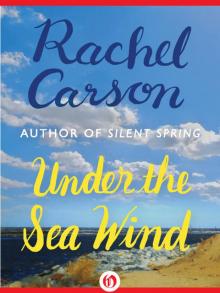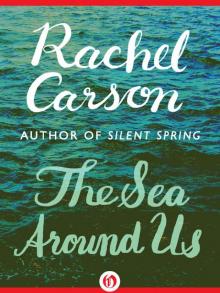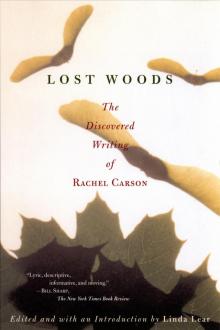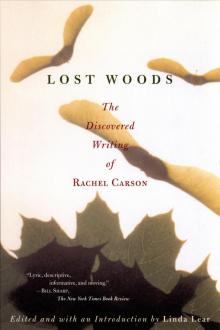- Home
- Rachel Carson
The Edge of the Sea
The Edge of the Sea Read online
The Edge of the Sea
Rachel Carson
* * *
with illustrations by Bob Hines
and a new introduction by Sue Hubbell
* * *
A MARINER BOOK
Houghton Mifflin Company
BOSTON NEW YORK
* * *
FIRST MARINER BOOKS EDITION 1998
Introduction copyright © 1998 by Sue Hubble
Text copyright © 1955 by Rachel L. Carson
Text copyright © renewed 1983 by Roger Christie
Illustrations copyright © 1955 by Robert W. Hines
Illustrations copyright © renewed 1983 by Robert W. Hines
ALL RIGHTS RESERVED
For information about permission to reproduce selections from
this book, write to Permissions, Houghton Mifflin Company,
215 Park Avenue South, New York, New York 10003.
Visit our Web site: www.houghtonmifflinbooks.com
Library of Congress Cataloging-in-Publication Data
Carson, Rachel, 1907–1964.
The edge of the sea / by Rachel Carson ; with illustrations by
Bob Hines and a new introduction by Sue Hubbell.—
Ist Mariner Books ed.
p. cm.
"A Mariner book."
ISBN-13: 978-0-395-07505-0 ISBN-13: 978-0-395-92496-9 (pbk.)
ISBN-10: 0-395-07505-x ISBN-10: 0-395-92496-0 (pbk.)
1. Seashore biology. I. Hubbell, Sue. II. Tide.
QH95.7.C385 1998
578.769'9—dc21 98-44435 CIP
PRINTED IN THE UNITED STATES OF AMERICA
QUM 16 15 14 13 12 11 10
Parts of this book first appeared in The New Yorker.
* * *
To Dorothy and Stanley Freeman
who have gone down with me into the low-tide world
and have felt its beauty and its mystery.
* * *
Contents
Acknowledgments xi
Preface xiii
Introduction xv
I. The Marginal World 1
II. Patterns of Shore Life 9
III. The Rocky Shores 39
IV. The Rim of Sand 125
V. The Coral Coast 191
VI. The Enduring Sea 249
Appendix: Classification 251
Index 271
* * *
Acknowledgments
OUR UNDERSTANDING of the nature of the shore and of the lives of sea animals has been acquired through the labor of many hundreds of people, some of whom have devoted a lifetime to the study of a single group of animals. In my researches for this book I have been deeply conscious of the debt of gratitude we owe these men and women, whose toil allows us to sense the wholeness of life as it is lived by many of the creatures of the shore. I am even more immediately aware of my debt to those I have consulted personally, comparing observations, seeking advice and information and always finding it freely and generously given. It is impossible to express my thanks to all these people by name, but a few must have special mention. Several members of the staff of the United States National Museum have not only settled many of my questions but have given invaluable advice and assistance to Bob Hines in his preparation of the drawings. For this help we are especially grateful to R. Tucker Abbott, Frederick M. Bayer, Fenner Chace, the late Austin H. Clark, Harald Rehder, and Leonard Schultz. Dr. W. N. Bradley of the United States Geological Survey has been my friendly advisor on geological matters, answering many questions and critically reading portions of the manuscript. Professor William Randolph Taylor of the University of Michigan has responded instantly and cheerfully to my calls for aid in identifying marine algae, and Professor and Mrs. T. A. Stephenson of the University College of Wales, whose work on the ecology of the shore has been especially stimulating, have advised and encouraged me in correspondence. To Professor Henry B. Bigelow of Harvard University I am everlastingly in debt for encouragement and friendly counsel over many years. The grant of a Guggenheim Fellowship helped finance the first year of study in which the foundations of this book were laid, and some of the field work that has taken me along the tide lines from Maine to Florida.
* * *
Preface
LIKE THE SEA ITSELF, the shore fascinates us who return to it, the place of our dim ancestral beginnings. In the recurrent rhythms of tides and surf and in the varied life of the tide lines there is the obvious attraction of movement and change and beauty. There is also, I am convinced, a deeper fascination born of inner meaning and significance.
When we go down to the low-tide line, we enter a world that is as old as the earth itself—the primeval meeting place of the elements of earth and water, a place of compromise and conflict and eternal change. For us as living creatures it has special meaning as an area in or near which some entity that could be distinguished as Life first drifted in shallow waters-reproducing, evolving, yielding that endlessly varied stream of living things that has surged through time and space to occupy the earth.
To understand the shore, it is not enough to catalogue its life. Understanding comes only when, standing on a beach, we can sense the long rhythms of earth and sea that sculptured its land forms and produced the rock and sand of which it is composed; when we can sense with the eye and ear of the mind the surge of life beating always at its shores—blindly, inexorably pressing for a foothold. To understand the life of the shore, it is not enough to pick up an empty shell and say "This is a murex," or "That is an angel wing." True understanding demands intuitive comprehension of the whole life of the creature that once inhabited this empty shell: how it survived amid surf and storms, what were its enemies, how it found food and reproduced its kind, what were its relations to the particular sea world in which it lived.
The seashores of the world may be divided into three basic types: the rugged shores of rock, the sand beaches, and the coral reefs and all their associated features. Each has its typical community of plants and animals. The Atlantic coast of the United States is one of the few in the world that provide clear examples of each of these types. I have chosen it as the setting for my pictures of shore life, although—such is the universality of the sea world—the broad outlines of the pictures might apply-on many shores of the earth.
I have tried to interpret the shore in terms of that essential unity that binds life to the earth. In Chapter I, in a series of recollections of places that have stirred me deeply, I have expressed some of the thoughts and feelings that make the sea's edge, for me, a place of exceeding beauty and fascination. Chapter II introduces as basic themes the sea forces that will recur again and again throughout the book as molding and determining the life of the shore: surf, currents, tides, the very waters of the sea. Chapters III, IV, and V are interpretations, respectively, of a rocky coast, the sand beaches, and the world of the coral reefs.
The drawings by Bob Hines have been provided in abundance so the reader may gain a sense of familiarity with the creatures that move through these pages, and may also be helped to recognize those he meets in his own explorations of the shore. For the convenience of those who like to pigeonhole their findings neatly in the classification schemes the human mind has devised, an appendix presents the conventional groups, or phyla, of plants and animals and describes typical examples. Each form mentioned in the book itself is listed under its Latin as well as its common name in the index.
* * *
Introduction
RACHEL CARSON died in the springtime of 1964, a woman of only fifty-six years, with an established literary reputation and fame, too. She had written four books by that time, all excellent in varying ways and every one a bestseller.
Silent Spring, with its revelations about pesticides and th
eir effects on the natural world, had been the most recent, published less than two years before cancer and its complications took her life. Its popularity with the general reading public—the right book at the right time—made her a pioneer of what we now call environmentalism. This reputation has made a great many people forget that Rachel Carson was first and foremost a writer of considerable literary style whose true love was the sea.
She was, by training, a marine zoologist, and her books before Silent Spring all had been about one aspect or another of the oceans. Part of the reason Silent Spring came to be such a success was that those previous books had established her name. Nevertheless, today her books on the sea seem to be all but forgotten, which is a shame, since in many ways a book such as The Edge of the Sea is more approachable, better written, and more relevant today than the monumental but now somewhat dated Silent Spring.
In October 1955, shortly after The Edge of the Sea was published, John Leonard, already a man who could make words dance, if not yet the gonzo reviewer he was to become, urged "modern city dwellers [who] go down to the sea in bathing suits ...[and] get bored by too much lolling" to buy the book and read it. He wrote that it was "beautifully written, and technically correct." After forty years that is still good advice and not a bad assessment, even though the continuing process of discovery that is science has outdistanced Rachel Carson's facts to some degree.
However, an evaluation in today's intellectual climate would point out that The Edge of the Sea was also a pioneering piece of writing from an ecological perspective, a perspective that was still new and shiny in the 1950s, a perspective that Carson, almost as much as anyone, brought to the reading public's attention as she struggled with her approach to writing this book.
It was a struggle because her original intent had been to write something rather like a field guide, but she soon realized that it was more interesting to write about the relationships among the seashore plants and animals and how the tides and the climate and geological forces affected them.
The book she finally ended up with was, and still is, a pleasure to read. We feel as though a well-informed friend has taken us by the hand as we walk along the ocean's rim and explained all the bits of the world that we see, giving us an understanding of how they fit together and pointing out some other bits that we failed to notice before but always will notice now that we know about them.
Before the turn of the century, the great German zoologist Ernst Haeckel used the term oecology to mean the study of the "economy of animals and plants." It was not until decades into the present century that the study of organisms as part of a community, subject to a changing world—biology in context—gained wide scientific acceptance and entered the biological lexicon as ecology. And it was mid-century before the general public, reading books like Rachel Carson's, began to understand this way of looking at the world as distinct from the older presentation of series of biological life histories, isolated and untouched by external forces.
According to Paul Brooks, the editor of The Edge of the Sea, Rachel Carson's original plan was to write a series of entries on what is to be found along the sea's edge. The book made from them would have been entitled A Guide to Seashore Life on the Atlantic Coast. It would have been a less integrated, altogether less "ecological" book. But as she began to write, Carson grew more and more uncomfortable with the idea behind the book. The idea had had two parents—a publisher and a writer; in the end the writer got custody of the baby.
The gestation of the idea began when Rosalind Wilson, an editor at Houghton Mifflin, invited a group of literary folks "lacking in biological sophistication" to her home on Cape Cod for the weekend. While walking on the beach they found horseshoe crabs that they believed had been stranded by the storm the night before. They were compassionate, if unknowing, and so they returned all of them to the sea. The horseshoe crabs would have regarded the incident as a terrible setback to their life plan, for they had lumbered ashore to lay their eggs.
When Rosalind Wilson returned to her office in Boston on Monday morning, she sat down and typed out a memo suggesting that Houghton Mifflin find an author who could write a guidebook that "would dispel such ignorance." Soon after, while Rachel Carson was still writing the book that was to be her first bestseller, The Sea Around Us, the proposal for such a guidebook was put to her and she accepted.
The proposal must have sounded to her like a book she had wanted to write for several years. As early as 1948 she had written her literary agent, Marie Rodell, "Among my remote literary projects is a book on the lives of shore animals, which Mr. Teale once asked me to write for his benefit."
In 1950, she wrote to Paul Brooks that for each important form of life the book would include a "biological sketch ... which, while brief, suggests a living creature and illuminates the basic conditions of its life: why it lives where it does, how it has adapted its structures and habitat to its environment, how it gets food, its life cycle, its enemies, competitors, associates." She wanted "to take the seashore out of the category of scenery and make it come alive ... An ecological concept will dominate the book." At Houghton Mifflin, renowned for its excellent field guides, these "biological sketches" must have seemed quite straightforward. But to a writer nothing is straightforward, and to an ecological thinker, which is what Rachel Carson was, the biological sketches developed into something more complicated.
Carson was hard at work on the book when, in 1953, she wrote plaintively to Brooks, "Why is it such agony to put on paper?" Very soon thereafter she wrote to him again. "I decided that I have been trying for a very long time to write the wrong kind of book.... I think we could say that the book has become an interpretation of ... types of shore.... As I am now writing, the routine ... facts, that were so difficult for me to incorporate into the text, are now being saved for the captions ... or for a tabular summary I'd like to tuck in at the end of the book. This solution frees my style to be itself; the attempt to write a structureless chapter that was just one little thumbnail biography after another was driving me mad. I don't know why I once thought I should do it that way, but I did."
Paul Brooks told me that she had been halfway through the writing of the book when she scrapped it and began again to write what became The Edge of the Sea. Lucky she did so; it is a better and more enduring book than A Guide to Seashore Life would have been, and current guidebooks can bring us up to date on recent discoveries to supplement it.
Despite her fame as the author of Silent Spring, Carson's deep interest lay with the ocean, as witnessed not only by her three books concerning it and its shores and her formal education in marine zoology, but also by the fact that as soon as she was able financially to afford it, she bought a property on the coast of Maine—and there she built a home in which she lived for a good part of every year and did much of her writing. At her request, after her death, some of her ashes were scattered off Cape Newagen, near that home.
It wasn't until she was forty-six years old that sales of her second book, The Sea Around Us, allowed her to move to the seashore. As a young woman, still in graduate school at Johns Hopkins, she had begun assuming the financial responsibility for her family, a responsibility that increased over the years as first her mother and then an ailing niece with a son moved in with her. When the niece died, Carson adopted the son. Later she went to work as an aquatic biologist and editor at the U.S. Fish and Wildlife Service and sold free-lance articles wherever she could for whatever fee she could command. It wasn't easy.
She never married.
Rachel Carson was born in 1907 and grew up in rural Springdale, Pennsylvania, slightly northeast of Pittsburgh. Her mother encouraged bookish Rachel in her interests in the natural world. And there she became fascinated with the world's oceans and read what she could find about them. I can testify to a midwesterner's yearning for the sea, for I grew up in that part of the country and to me the ocean came to represent force, power, mystery, and great beauty, a vivid contrast to my everyday world, and I a
lways assumed that someday I would live beside it. It wasn't until I was well into my seventh decade that I acted on that assumption. But now, in a home not too distant from Rachel Carson's, I can watch the tide pull the sea from the shore and return it as I write this introduction.
As a very young woman Carson believed that for a career she would have to choose between her scientific interest in the ocean and her already developed skills in and love of writing. It wasn't until the 1930s that she found a way to blend the two. It was then that she recalled reading Tennyson: "On a night when rain and wind beat against the windows of my college dormitory room, a line from Locksley Hall burned itself into my mind—
For the mighty wind arises, roaring seaward, and I go."
Paul Brooks is retired now, but I telephoned him at home one day and asked him if he thought she would have returned to the sea as a subject for additional books had she lived, or whether the success of Silent Spring would have pushed her writing in another direction. "Well I'm not sure," he said. "She'd talked for years about doing a book that was vast and unfocused, that was about Life Itself. I'm glad she never wrote it, because it always sounded too vague and too broad. And although Silent Spring was a tremendous success, she never saw herself as a crusader. She just felt compelled to write that book. But, no, I don't think she was finished with the sea as a subject."
Today we need a Rachel Carson to write about ocean "dead zones," the degradation of ocean habitats, the dying of coral reefs, the effects of global warming on ocean waters. And of the last, the reader will find on the early pages of The Edge of the Sea that Carson was already writing, in the early 1950s, about how ocean life was being changed by warming waters.

 Silent Spring
Silent Spring Under the Sea Wind
Under the Sea Wind The Edge of the Sea
The Edge of the Sea The Sea Around Us
The Sea Around Us Lost Woods: The Discovered Writing of Rachel Carson
Lost Woods: The Discovered Writing of Rachel Carson Lost Woods
Lost Woods